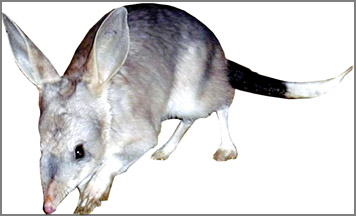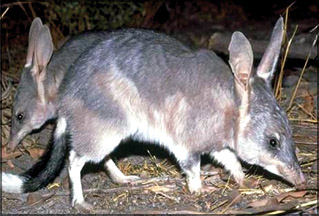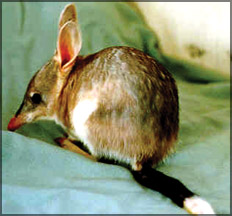|
Bilbies:
Desert dwelling marsupials
  It
is only in Australia one would find unique animals such as mammals that
lay eggs (platypuses) and swans that are black feathered. There are many
more strange or wierd looking creatures Down Under, but the animal we
feature today may be rather strange in appearance yet it's considered to
be cute too in its own special way. It
is only in Australia one would find unique animals such as mammals that
lay eggs (platypuses) and swans that are black feathered. There are many
more strange or wierd looking creatures Down Under, but the animal we
feature today may be rather strange in appearance yet it's considered to
be cute too in its own special way.
If anyone of you isn't familiar with this little creature, let us
introduce you to it.
The bilby (Marcotis lagotis) which is virtually an Australian icon
today is a desert dwelling marsupial which is an endangered species. It
is a member of the order Peramelemorphia and a close relative of the
bandicoot.
Before Australia was colonized, two species had existed, but with
time, one species known as the Lesser bilby had become extinct in the
1950s. The Greater bilby is the species presently in existence and major
efforts are under way to protect it also from becoming extinct.
The word bilby in Aboriginal language means rabbit-eared bandicoot or
long-nosed rat. It has been nicknamed 'pinkie' in South Australia and
dalgite in western Australia.
The Greater bilby too is categorised as the western bilby (Marcotis
la'gotis lagotis) and the eastern bilby (Marcotis' lagotis sagitta).
Obviously these names have come about as a result of its appearance.
Let's check out what its 'strange looks are.
The bilby has a characteristic long bandicoot muzzle (or nose) and
long, rabbit-like ears which are between 29and35 cm in length. These
huge, almost hairless ears aid the bilby to keep cool and also increase
its level of hearing.
The bandicoot-like muzzle or snout is pink and hairless at the tip.
The tail, which is longer than that of a bandicoot (about 29 cm) is
black with a white crest at the end, and a naked spur-like tip. Its
soft, silky fur is bluish-grey in colour with fawn thrown in. The little
creature is 55cm in length (excluding tail) and weighs about 2.5 kg.
Females however are almost half this size.
Even though bilbies have good hearing, their eyesight is poor. But
they have strong forelimbs and well-developed claws. And guess what?
This makes them excellent burrowers.
Bilbies are known to build extensive tunnel systems. Typically, a
bilby would build about a dozen burrows within its home range. Then,
when it wants to beat the heat or play 'hide and seek' with predators,
it would move between these tunnels.
  It
goes into the burrow an hour before dawn and emerges only about an hour
after dusk. It is believed to be a strictly nocturnal (night time)
animal. It
goes into the burrow an hour before dawn and emerges only about an hour
after dusk. It is believed to be a strictly nocturnal (night time)
animal.
We mentioned earlier that the bilby is a marsupial. Now some of you
may be aware that marsupials have pouches in which their offspring grow.
For instance, the kangaroo is a marsupial and it has a pouch in which
the baby kangaroo grows and also jumps into as and when it wants, even
when it is quite grown up.
So, the mama bilby also has a pouch, but there is a small difference.
Since the small sized bilbies are burrowers, the possibility of dirt
getting into this pouch is strong. Therefore the pouches of bilbies are
formed facing backward, not forward like those of kangaroos.
By the way, there is another interesting fact when it comes to
bilbies and reproduction. According to researchers, the bilbies have the
shortest gestation (time of pregnancy) among mammals. It amounts to
12-14 days the most. And even though the females have the capacity to
nurse up to eight young in one go, they normally litter only two baby
bilbies at a time.
The tiny bilby babies live in the pouch for 70-80 days. Then they are
released into the burrow for mother dear to nurse. They continue to
suckle mother's milk for another two weeks while in the burrow. These
little ones are able to take care of themselves only when they are about
six months old. Then they start eating solid food.
Now, if you are wondering what the bilbies eat to grow and survive,
here's the menu.
As bilbies are omnivorous they eat insects, their larvae, seeds,
bulbs, fruits, fungi and very small animals. Most of their food is found
by digging or scratching the soil.
And their long tongues come in handy to get at their food. Well, now
we know what they eat, but hey, what about water? Don't they get
thirsty, especially since they live in arid (desert) country? Of course,
all creatures need water to survive, but bilbies generally get their
requirements of water from the food they eat.
  This
solitary species of animal once inhabited about 70 per cent of
Australia, but sadly its numbers have reduced greatly today. And guess
who its number one enemy is - not humans in this instance, but the cute
and harmless furry creature we all love generally, the rabbit. To be
more specific, the European wild rabbit. This
solitary species of animal once inhabited about 70 per cent of
Australia, but sadly its numbers have reduced greatly today. And guess
who its number one enemy is - not humans in this instance, but the cute
and harmless furry creature we all love generally, the rabbit. To be
more specific, the European wild rabbit.
With a national recovery plan in action to save the endangered bilby,
it is not surprising that Easter bunny is not as popular among some
Australians as it used to be.
The bilbies enemy who dominate the Easter festivities is now being
replaced; Easter bilby's are taking over, slowly but surely. Who knows,
the rabbit might just have to hop, hop away for good, at least in
Australia. Even if the bilby cannot conquer the world, it may certainly
conquer Australia, going by the mileage the bilby campaigns have gained
so far.
Fact file
* These endangered animals have a special
day of their own. National Bilby Day was officially launched
in 2005. Celebrations are held on the second Sunday of
September annually. This year it fell on September 14.
* Bilbies are members of the order
Peramelemorphia though some researchers place them in
various other orders.
* The term bilby is a loan word from
Yuwaalaraay Aboriginal language of northern New South Wales.
* The national recovery plan includes
breeding in captivity, monitoring populations and
reestablishing bilbies in areas where they once lived.
* Efforts are being made to popularise
bilbies as a native alternative to the Easter Bunny by
selling chocolate Easter Bilbies.
* Passionate environmentalists, Frank
Manthey and Peter McRae are known as the ‘Bilby Brothers’.
According to Frank (Queensland Park and Wildlife Service)
the bilby is a “unique little Australian icon”, which needs
to be preserved for future generations.
* The bilby is also known as pinki,
dalgyte, ninu and walpa.
* In 1994, the South Australian Bilby
Recovery Team was formed to coordinate the recovery of this
unique animal in South Australia.
* The bilby has a great sense of hearing,
but poor eyesight.
* Their burrows are very deep, spiralling
downwards, making it difficult for predators to get into
them. |
|
